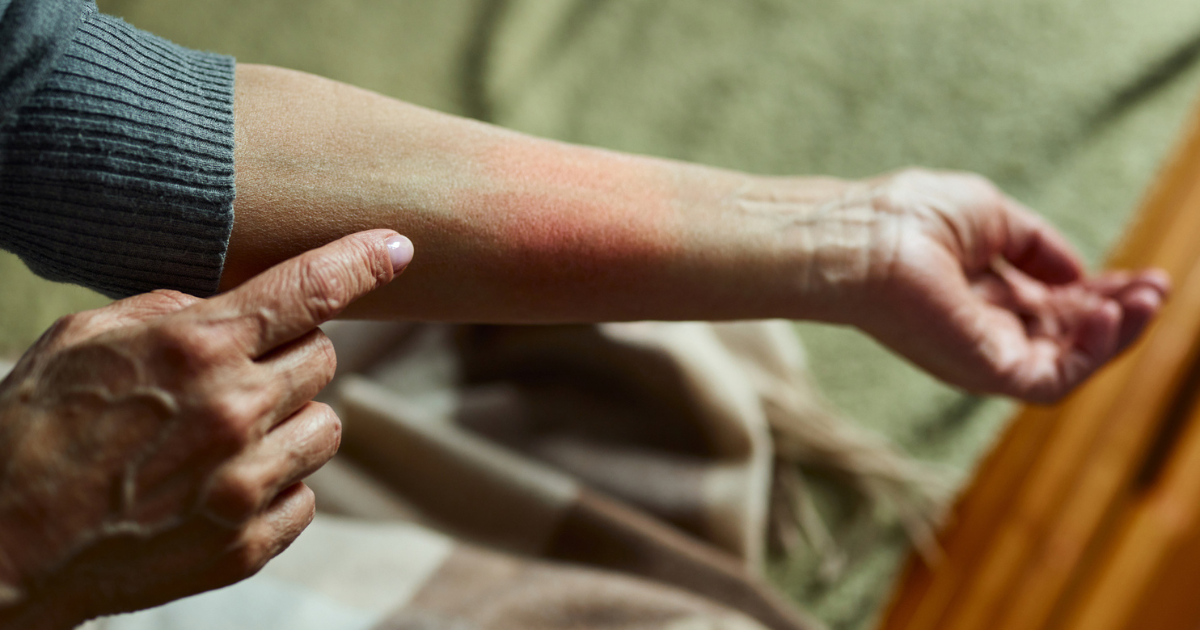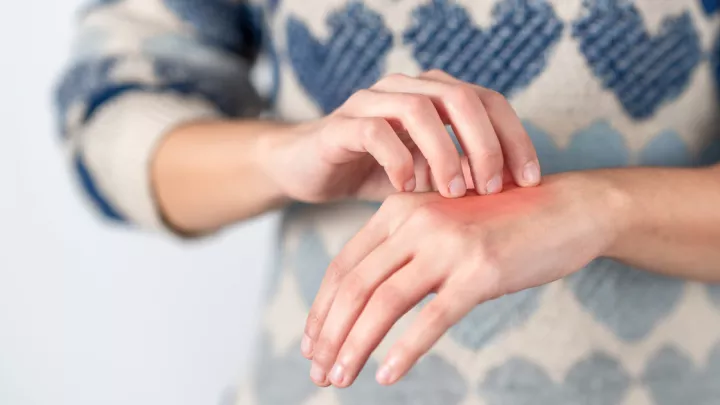How to treat dry, itchy skin

Dry, itchy skin can be due to a dermatologic condition called contact dermatitis, which is one of the most common types of skin rashes that occurs among people in the general public. There are two primary types of contact dermatitis. These include allergic contact dermatitis, caused by an allergy; or irritant contact dermatitis, caused by exposure to an irritating substance that aggravates or damages your skin.
Irritant contact dermatitis
“Irritant contact dermatitis is the more common of the two and can often be self-managed if you can determine the source,” says Nebraska Medicine dermatologist Nicole Harter, MD.
Many people develop some degree of contact dermatitis that is associated with dry, cracked skin during the winter due to cold, dry weather and frequent hand-washing.
Skin conditions like eczema or other dry, itchy skin problems may also flare up during the winter months. The best way to prevent dry skin flare-ups is to take extra measures to keep the skin well hydrated, avoid harsh soaps like anti-bacterial soaps, limit long, hot showers and apply moisturizers immediately after hand-washing and showering.
Other common causes of irritant contact dermatitis include:
- Laundry detergents
- Paints and varnishes
- Hair dyes
- Nail polish remover
- Acids
- Resins, plastic and epoxies
- Some plants, such as poinsettias and peppers
Exposure to these irritants, as well as cases of allergic contact dermatitis, can create more severe symptoms that may include the following:
- Raw, weeping blisters
- Dry, cracked skin
- Itching skin
- Redness and/or raised red rash
- Inflammation
- Burning and tenderness
Irritant contact dermatitis can be associated with more burning and painfulness than itchiness. Symptoms typically occur in the area that was exposed to the irritant and can develop very quickly.
Allergic contact dermatitis may develop over a day or two after the exposure and is often very itchy.
Dr. Harter recommends treating the area with fragrance-free moisturizers, gentle cleansers, petroleum jelly-based products that help restore the skin’s natural barrier, and the application of topical over-the-counter creams like hydrocortisone to reduce itching.
“If you avoid the irritant and treat the rash, you will usually see a marked improvement within a week,” says Dr. Harter.
If the blistering and itching continue with little or no relief, Dr. Harter recommends seeing a doctor. “This is especially important for people with a history of atopic dermatitis or eczema as their skin barrier is already weakened and is at greater risk for developing a bacterial infection in addition to the contact dermatitis,” she says.
Allergic contact dermatitis
Allergic contact dermatitis is caused by an allergic reaction from your immune system to something you have come into contact with.
“Surprisingly, sometimes allergic reactions can happen from something you have used for years like a perfume or detergent,” says Dr. Harter. “It’s also important to remember that you usually won’t get a rash the first time you are exposed to the allergen. The first contact sensitizes the skin. The second contact is when the allergic reaction can occur.”
Common allergens include:
- Hair dyes and straighteners
- Poison ivy, poison oak and poison sumac
- Perfumes and fragrances in soaps, shampoos and lotions
- Nickel, often found in jewelry or belt buckles
- Some medications that are put on the skin (such as over-the-counter antibiotic ointment)
- Citrus fruit, especially the peel
Finding the cause of allergic contact dermatitis can be a little more difficult,” says Dr. Harter. “If you are not able to identify the trigger, you will want to see a dermatologist to help you determine the cause.”
“We will start with an investigative interview to review different types of common triggers you may be using regularly,” explains Dr. Harter.
“We will then recommend an elimination period where you will be asked to eliminate common skin care products known to cause allergic reactions. If the trigger still isn’t apparent, we may recommend patch testing.”
Patch testing involves attaching up to 100 small patches containing different formulations of common potentially allergenic substances to your back. After two days, you will return to your doctor’s office to see if you have developed any redness or skin reaction under the patches.
“Treatment for allergic contact dermatitis may require a topical steroid to calm the area down,” notes Dr. Harter. “For some allergic reactions, like poison ivy, a short course of an oral steroid may be needed as well.”
When to see a doctor
- The rash persists despite home treatment remedies and attempts to remove the irritant or trigger.
- You develop painful raw areas with blistering, pus or drainage.
“You should not continue to suffer or let blisters fester,” says Dr. Harter. “We have stronger medications and treatments that can help relieve the symptoms and quicken your recovery.”
Call 800.922.0000 to schedule an appointment with one of our dermatologists.







